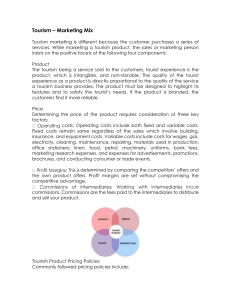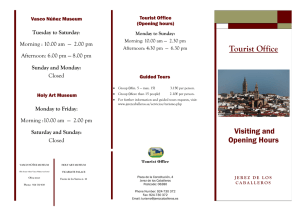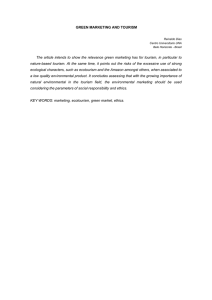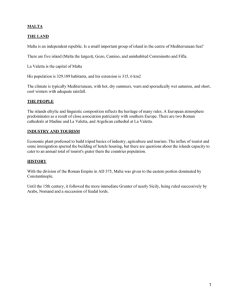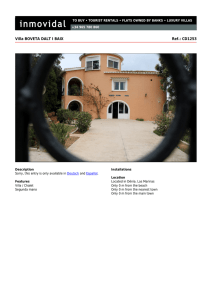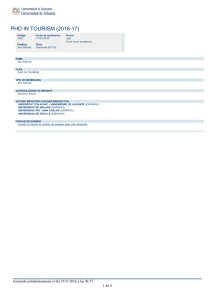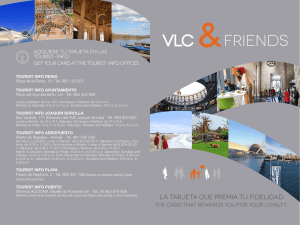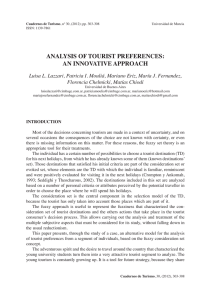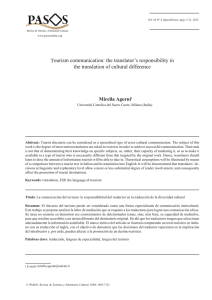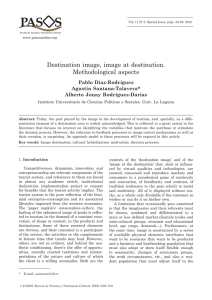an analysis of the tourist perception in the region tánger
Anuncio
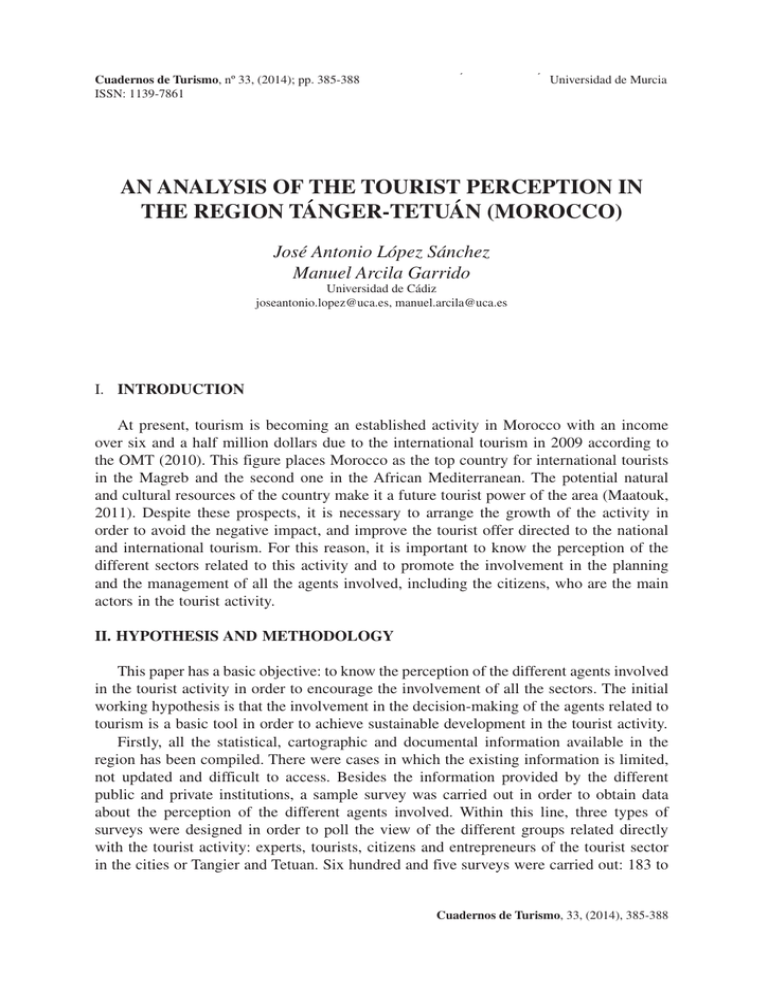
Cuadernos an analysis de Turismo, of the tourist nº 33, (2014); perception pp. 385-388in the region TÁNGER-TETUÁNUniversidad (morocco) de Murcia 385 ISSN: 1139-7861 an analysis of the tourist perception in the region TÁNGER-TETUÁN (morocco) José Antonio López Sánchez Manuel Arcila Garrido Universidad de Cádiz joseantonio.lopez@uca.es, manuel.arcila@uca.es I. INTRODUCTION At present, tourism is becoming an established activity in Morocco with an income over six and a half million dollars due to the international tourism in 2009 according to the OMT (2010). This figure places Morocco as the top country for international tourists in the Magreb and the second one in the African Mediterranean. The potential natural and cultural resources of the country make it a future tourist power of the area (Maatouk, 2011). Despite these prospects, it is necessary to arrange the growth of the activity in order to avoid the negative impact, and improve the tourist offer directed to the national and international tourism. For this reason, it is important to know the perception of the different sectors related to this activity and to promote the involvement in the planning and the management of all the agents involved, including the citizens, who are the main actors in the tourist activity. II. HYPOTHESIS AND METHODOLOGY This paper has a basic objective: to know the perception of the different agents involved in the tourist activity in order to encourage the involvement of all the sectors. The initial working hypothesis is that the involvement in the decision-making of the agents related to tourism is a basic tool in order to achieve sustainable development in the tourist activity. Firstly, all the statistical, cartographic and documental information available in the region has been compiled. There were cases in which the existing information is limited, not updated and difficult to access. Besides the information provided by the different public and private institutions, a sample survey was carried out in order to obtain data about the perception of the different agents involved. Within this line, three types of surveys were designed in order to poll the view of the different groups related directly with the tourist activity: experts, tourists, citizens and entrepreneurs of the tourist sector in the cities or Tangier and Tetuan. Six hundred and five surveys were carried out: 183 to Cuadernos de Turismo, 33, (2014), 385-388 386 José Antonio López Sánchez & Manuel Arcila Garrido tourists, 177 to experts and consultants, and 245 to citizens. The three types of surveys were carried out homogeneously in the cities of Tangier and Tetuan, in addition, another five per cent was distributed in the city of Larache. III. THE IMPORTANCE OF TOURISM IN THE REGION OF TÁNGER-TETUÁN In order to know the tourist activity of this region the resources of the zone, the development of the current offer and the existing demand need to be analyzed. This in-depth analysis of the sector is based on the statistical data of different institutional sources which will be used to contextualize and assess accurately the view of the different agents polled and which is analyzed below (SAÏGH, 2005). Also, the results obtained of the survey carried out in the area have been used. The region Tangier-Tetuan is located in the surroundings of the Strait of Gibraltar, which connects the Atlantic Ocean and the Mediterranean Sea. This geographical location provides climatic conditions very similar to the ones in the South of Spain, with a yearly average temperature between 14 and 18 degrees, yearly average rainfall of 800 mm and a very high daily average number of bright sunshine hours. Likewise, its 375 kms of coast make it the ideal place for the development of sun and beach tourism (Azzariohi, 2010). The main beaches are located in the Atlantic coast, although some of them are situated between Cabo Negro and Martíl in the province of Tetuán (Hilali, 1995). Besides these coastline features there are more natural and cultural resources in the province of Chefchaouen, in the south-east of the city of Tetuan, specially the capital city and its national park, which spreads across most of the territory (National parks Talassemtane and Bouhachem are being developed). The cultural patrimony has not been fully exploited yet. The ancient and well preserved old cities are an attraction that need to be enhanced, as well as the historic and archaeological resources of the region. These resources need a policy of protection, restoration and value enhancement of the patrimony, which will enable a significant improvement of the tourist offer (Arcila et al, 2011). A meaningful example would be the city of Tamuda, in the surroundings of Tetuan which, in spite of its undeniable historic importance (D. Bernal; B. Raissouni, A.M.; Sáez, M.; Bustamante, J.J.; Díaz, M.; Lara, M.; Ghottes, J.A.; Riquelme, J.; Lagóstena and J. Verdugo, 2011) is not very well known. Urban tourism in the North of Morocco is linked to cultural and heritage tourism. In the region there are cities of a great tourist and heritage interest such as Tánger, Tetuán, Asilah, Martíl, Larache y Chefchaouen (López et al (a), 2011) but they lack the suitable infrastructure and equipment from a tourist point of view. Some deficiencies have also been detected in the policies of tourist exploitation of these resources and in the coordination between the different public administrations and the private sector. In fact, the institutional planning is causing an increase in the international tourism in the last decade rising from two and a half million in 1995 to more than nine million in 2010 (OMT, 2011). This means an increase of 256 %, with a higher growth in the first decade of the 21st Century than in the last years of the 20th Century. This statement is confirmed by the observation of the income generated by tourism which rises exponentially in the studied period. On the other hand, when analyzing the share of participation in Cuadernos de Turismo, 33, (2014), 385-388 an analysis of the tourist perception in the region TÁNGER-TETUÁN (morocco) 387 Morocco of the international arrivals and the weight represented within African tourism, its importance is compared as the relative weight has been increasing steadily from 1995 with 13% to 2010 with 20%. This growth in the share of tourist arrivals is corroborated with the relative weight which represents Morocco in the African environment in relation to the income obtained in this sector. table 1 the development of entries across THE MOROCCAN border Nationality 2001 2007 2008 Var % 07/08 Spain 77.344 138.205 147.063 6 France 38.443 71.589 76.605 7 United Kingdom 21.622 28.984 28.040 -3 Arab countries 14.233 18.185 17.902 -2 Germany 18.200 15.252 14.618 -4 United States 27.707 13.468 12.232 -9 Portugal 8.249 12.166 12.024 -1 Italy 7.000 7.875 10.545 34 The Netherlands 4.564 8.367 7.662 -8 Source: Tourist Observaroty and yTourism Ministry Morocco, 2010. Most foreign tourists (50%) arrive in Morocco across the border located in the region Tánger-Tetuán, usually by land (Ceuta) and by sea (Tangier). In the region Tánger-Tetuán, 18% of the tourists (1.503.514) crossed the Moroccan border through the Tangier port. IV. THE PERCEPTION OF TOURIST ACTIVITY IN THE REGION TángerTetuán In this section are shown the results obtained in the surveys carried out in the cities of Tánger, Tetuán and Larache between tourists, citizens and tourist agents in the framework of the cooperation project Ibn Battotuta. The comparison between the views of the tourists, citizens and tourist agents regarding the tourist activity is significant, as it can be stated that the perception of some elements is very different. The reason for this might be the different experiences lived in the same reality or the existence of different criteria of assessing quality. As far as tourist signposting is concerned, the views are similar between the tourists, citizens and tourist agents, being in general very negative, especially for the tourists. Cuadernos de Turismo, 33, (2014), 385-388 388 José Antonio López Sánchez & Manuel Arcila Garrido Likewise, the views regarding the leisure offer and public transport are similar in the three groups analyzed, being again considered negative or very negative. In the rest of the points analyzed, the perceptions are different, and even opposed. The most meaningful example is the view about hotels, in which the difference between the percentage of the tourists, who think that the offer is bad or very bad and the experts who support this view is almost 60 points. In the case of the roads, the citizens have the worst opinion about their condition. On the other hand, the tourists and the experts are more lenient when assessing the infrastructure, probably because they are aware of the economy and social reality of the country. It is noteworthy the high opinion of the tourists about the restoration establishments compared to the opinion of the experts. V. Conclusion It is confirmed the importance of tourism in the region and its potentiality as a means of sustainable development if some basic criteria, which are currently being omitted, are taken into account, such as the sustainable management from the Administration, the minimizing of environmental impact, the preservation of the cultural heritage as source of wealth, the maximizing of the benefits of the environment and the development of a sustainable and diversified economy. It can be said that there is a political willingness to consider these lines as they appear in the plan Azur 2020 (Inspection Regionale, 2011) although it is not reflected in a sustainable management tangible by the Administration. Cuadernos de Turismo, 33, (2014), 385-388
